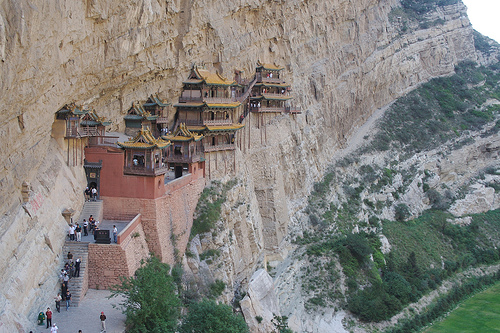

Location: 40 mi (65 km) Southeast of Datong, Shanxi province Map
Tel. (0355) 832 7417
Entrance Fee: 130 yuan
Open: 7am- 6pm daily
Hanging Temple or Datong Hanging Temple is a Buddhist temple complex located 40 mi (65 km) Southeast of Datong in Shanxi province in China. Hanging Temple was constructed in 491 AD at the base of Mount Hengshan on the cliff overlooking Jinzia Gorge at a height of 75 meters (246 feet) above ground. The whole structure is supported by the wooden oak beans that are inserted into a mountain. In some places it reached a height of three stories. The legend goes that the original structure began with a work of a single monk by a name of Liao Ran (了然). It was subsequently enlarged and improved by Ming Dynasty (1368- 1644) and Qing Dynasty (1644- 1911). It included Confucian, Taoist and Buddhist elements during its construction. Hanging Temple contains over 80 statues of iron cast, bronze, and clay statues. However several of Buddhist depictions were stolen over duration of several centuries.
In the monastery along the steep wall there are about 40 halls and pavilions. The buildings are kept on wooden stilts resting on the rock. The rock itself is also used as the rear wall of the premises, excavations in the rock are made for images and Buddha statues. In total there are 80 statues from different materials in the monastery. The largest relief sculpture is the Tathata The monastery since 1982 is protected as the National Monument of the PRC. Xuanqing-si is the only temple in China, in which three religious and philosophical schools are united: Buddhism, Taoism and Confucianism.
The monastery was built in 491. It is placed high up to protect itself from the rising waters of the river located 50 meters below.
The structure seems to rest on fine pillars of red wood erected vertically. In reality, the monastery rests on beams driven horizontally into the rock. The pillars are only an aesthetic choice reinforcing the perception of a site "placed" on the mountainside.